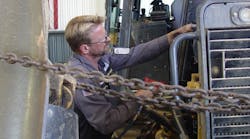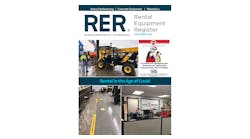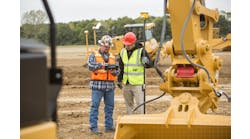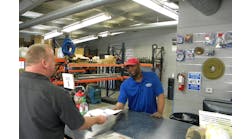The economy is better and there is more work for all in the world of rental. Still, the competition is fierce for every rental dollar. And as much competition as there is among rental companies, it’s just as tough for the contractors of the world. Therefore, their expectations for service are dramatically higher than ever before. Job bidding is extremely tight, and there is little margin for error. There is neither time nor tolerance for downtime, which can affect the difference between profit and loss on a project.
Not only is the expectation for almost-immediate repair far more prevalent, but communication on the status of an expected service truck or the process of a repair or delivery of a part also requires constant updating. If it’s possible in this era to be able to track the status of a UPS or Fedex — or even a postal service delivery — then the standard should certainly be no less when it comes to repairing a machine at a jobsite. Customers have too much to lose to be tolerant. There are competitors lining up to take that company’s place.
“Expectations are definitely increased in today’s environment,” says Mark Clawson, president of Diamond Rental, Salt Lake City. “In a world of instant communication, customers expect issues to be resolved quickly. That flows naturally to the resources and personnel that need to be focused on servicing equipment.” With so many methods of communication available, as simple as e-mail and text messaging, customers expect a proactive approach, much faster repairs from start to finish and frequent communication regarding repair status.
Rental companies need to be prepared to diagnose equipment quickly and accurately and to communicate clearly with the customer throughout the process. And since not all rental companies carry large parts inventories, communications with suppliers is critical to avoid keeping customers waiting.
Enhancing the technical capacity of service technicians is important as well. Chris Shields, general manager of parts and service for Hugg & Hall Equipment, based in Little Rock, Ark., adds that most of the equipment entering the marketplace during the past few years has gone through significant technical advancements. “Equipment, particular those affected by clean air regulations, are far from what we now consider to be basic mechanical, powertrain, hydraulic and electrical systems,” he says. “Training up technicians is costly.”
Mike Beksinski, head of service for Deer Park, N.Y.-based Able Equipment Rental, points out the need to be in a “permanent 24/7 mode with one-hour response time, onsite repairs of almost any size, hauling around every type of part and employing the best mechanics.”
Finding the “best mechanics” is not easy, and the difficulty in finding qualified technicians is a perennial challenge, perhaps now more than ever. “Today’s equipment is highly computerized and requires technically savvy individuals,” says Graham Hood, CEO of Miami-based Neff Rental. “With the evolution of today’s machines, there is a need for faster information exchange from schematics to DTC (data trouble codes) information. You also have to be able to react quickly and effectively to telematics alerts or condition-based maintenance.”
Not only do customers have higher expectations, but many of them chart the performances of rental companies when it comes to delivery, response and downtime. “Customers today keep better metrics on their end measuring jobsite productivity,” says John Hofmeyer of Elmhurst, Ill.-based Patten Industries. “And they are more than happy to share with you any lost productivity due to downtime and often are able to equate that in perceived dollars lost.”
Being proactive
Rental companies are increasingly proactive to make sure equipment doesn’t break down on the jobsite and are watching service intervals far more aggressively. For example, Patten Industries has a full-time preventive maintenance department that dispatches field service technicians often after hours or on weekends to maximize equipment operation and minimize customer inconvenience. Telematics systems play a significant role.
“Through remote monitoring/telematics, we now have access to the information we need to take a proactive approach to preventive maintenance,” says Jay Dinger, rental division manager, Louisiana Cat, Reserve, La. “We no longer have to rely on customers to supply equipment hours and location, and can begin the scheduling process much sooner to find the most convenient time to schedule downtime. Telematics allow us to start the troubleshooting process before reaching the jobsite. This aids in completing repairs in a more timely fashion and increases uptime. It also allows us to spot potential operator issues that may lead to downtime, and curb those behaviors before they result in downtime.”
Rental companies often pay attention to preventive steps before a machine leaves the shop to avoid service calls. “When a tech is doing a rental-ready inspection we encourage them to think about the unit going back out on rent,” says Mike Bierschbach, director of corporate fleet management, Stamford, Conn.-based United Rentals. “By empowering our technicians to be forward thinking, we can often do a maintenance step slightly before due while the unit is in our shop and prevent a field service call a few days after the rental starts. But longer rental periods still require that we do some preventive maintenance on site.”
Rental companies are in agreement about the importance of preventive maintenance, especially with higher-tiered engines. However, another factor that could influence equipment health and performance is third-party fuel, which generally cannot be controlled on a jobsite.
“With virtually every type of fuel tank out there, from site tanks to pickup truck bed tanks, the chance for fuel contamination is so high, which is a larger concern,” says Neff Rental’s Hood. “With new Tier 4 technology, regular periodic checks and timely preventative maintenance are more critical than ever.”
“Telematics has changed the game since we can review fault codes and machine condition monitoring,” sums up Patten’s Hofmeyer. “Information is far better than it used to be and helps us identify problematic issues or helps to better indicate, for example, what parts we need to stock. We also do regular extensive fluid sampling and testing to diagnose early component failures. Our check-in and final check over process is far more advanced, documented and thorough.”
Check the codes
Error codes on machines can be extremely effective in helping service technicians know what’s wrong even before arriving on a jobsite. Sometimes these codes can be viewed remotely; sometimes they are reported by the operator. While codes are not 100-percent foolproof, they can be tremendous timesavers in aiding rental companies to make sure they bring the correct tools and parts with them to the jobsite, often avoiding the need for a return trip.
“We utilize proprietary software to both track hours to identify when PM’s are required and also are able to often diagnose machines from fault codes transmitted via GPS,” says Hofmeyer. “This enables us be certain that the technician dispatched has proper parts on the truck and often eliminates troubleshooting since we have a pretty good idea of what is wrong with the machine prior to arrival. We’ve had instances where we’ve shown up on a jobsite to fix a problem before the customer even realized anything was wrong! And they really appreciate the fact that we proactively deal with minor issues before they lead to larger ones.”
“As part of our qualification process, we ask the caller for any codes which may be active and nearly always benefit when they are provided,” adds John Stride, president of Tallmadge, Ohio-based Leppo Equipment. “Frequently, the caller is someone other than the machine operator and may be physically nowhere near the equipment. In those cases, codes are often not available to us.”
Some rental companies use spread sheets or a computer program to diagnose the code when the customer calls it in. Still, inside sales staff should be trained to ask appropriate questions if the customer reports an issue.
Complete service trucks
A good service truck is a prerequisite for a rental company. Many are equipped with cranes, air compressors, hose-making capability, welders, almost all the fluids needed to maintain equipment and the capacity to change fluids, filters, and a healthy load of tools and parts.
Trucks also have to be able to adapt to changes in equipment, which can be challenging given the variety of brands many rental companies carry.
“We are replacing 11 trucks this year and are going with larger and better equipped versions of their predecessors,” says Hofmeyer. “With rare exception, our trucks today are equipped to enable technicians to do almost all repairs in the field.”
“For the most part, our trucks are equipped so that our technicians can diagnose the majority of machines in their local fleet and perform preventive maintenance on that same population of equipment,” adds United Rentals’ Bierschbach. “They can also do basic, non-invasive repairs right from the trucks. For repairs that will be time-consuming or deeply invasive to the machine we prefer to get these units back to a brick and mortar service center whether it is one of our locations or one of our dealer–distributor partners. That said, there are some locales where we have to do more time-consuming work onsite. Typically we will have one or more larger, more specialized trucks in the market that attack those projects.”
“All my trucks carry stock bulk hydraulic hose and fittings, we can make any hose that we need right on the jobsite,” adds Brian Omerod, vice president of product support for Cloverdale Equipment Co., Oak Park, Mich. “All our trucks have cranes on them, welders, generators; there’s not much we can’t do.”
Measure it
With the need for prompt response increasingly important, many rental companies have come up with metrics to measure their performance, including measurement of average downtime as well as response to breakdowns.
“Everything is logged down to the minute from when customer calls in to when the technician is dispatched, arrives on site and completes the job,” says Hofmeyer. “Our executive team regularly reviews response time from a benchmark perspective to identify areas we can improve. We also survey our customers each month and review their impression of how we are doing.”
“We measure service response times continuously,” says Bierschbach. “Our Customer Focused Branch Operations metrics are delivered to operations and organizational management on a regular basis. It can also be run on demand for a number of parameters including particular customer, location or cluster of locations. In addition, service response time is included in our repair and maintenance scorecard that is delivered to the appropriate service personnel each week.”
Omerod says Cloverdale keeps a log on all calls and tracks its trucks using GPS tracking. “We have a customer repair board to track repairs from the time the customer drops it off to when they pick it up.”
Not every company keeps charts or statistics. Some, such as Hugg & Hall’s Shields say that developing the technology to give the company a more accurate picture is a goal it has not reached yet. But clearly the sense of urgency has become much greater than in the past and whether a company’s goal is to be onsite within an hour, two hours or four, clearly rapid response is key.
Service evolution
The rental industry has evolved and become more professional in the past decade or so, and the shop has been no exception. So much of the fleet now has on-board computerization and shops’ practices and processes have become more efficient. Some rental companies are adding technicians to increase capacity, and in some cases working to develop specialization among those technicians. “Some techs [are] providing primarily road service while others primarily stay in the shop,” says Leppo’s Stride. “There are crews working almost exclusively on a specific category of equipment, e.g., aerial work platforms, compact equipment, lawn and garden, etc.”
Cloverdale’s Omerod has done the same, dividing the shops into divisions: crane, aerial, forklifts and general. “Field service is divided in the same manner,” he says. Diamond Rental has added “roving mechanics” to float among Diamond’s 10 locations on an as-needed basic and also handle onsite service calls. “This program has been one of our important changes aimed directly at decreasing equipment downtime while also quickly responding to equipment on job sites,” Diamond’s Clawson says.
Technology certainly adds to efficiency with telematics systems helping diagnose equipment problems in the field and reporting on problems before the problems become acute. Technology has also simplified documenting service history and assisting with processes such as parts procurement.
“Using SmartEquip has allowed us to be more accurate with ordering parts,” says Mike O’Neal of Fort Worth, Texas-based RentalOne. “It has sped up our processes tremendously, which allows us more uptime with our fleet.” An aggressive, preventive philosophy of solving problems before they manifest is being adopted by many companies, aided by the advanced technological tools being made available to them.
“We are constantly reviewing equipment data, such as fluid analysis, inspections, and electronic data to spot problems and present options to our customers to repair before failure,” says Louisiana’s Dinger. “We distribute this information to our field staff so they can get in front of customers and address these issues, rather than waiting for the customers to contact us as we did in the past.”
“The other big driving force to our service department is the advancing complexity of the equipment,” adds United Rentals Bierschbach. “Be it engine emissions or more electronic interfaces, the machines seem to get more complex every year. To address this added complexity, we have committed to an increased investment in our technicians and their tools. Those tools include their education and training.
“I do feel that this added complexity can be an opportunity to expand our technician profile. I would like to see the stereotype of the service tech being a ‘gear-head’ die. Our technicians are really problem solvers and solution providers. If we can foster that image out to the world I think we can appeal to a completely untapped market.”







